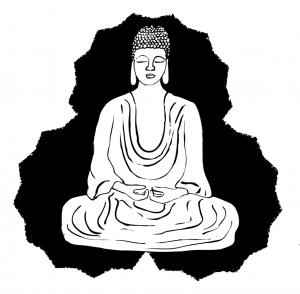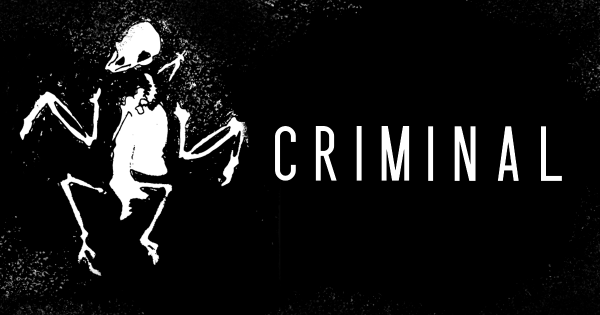Oakland resident Dan Stevenson was never the type to call the cops on drug dealers or prostitutes in his neighborhood. He took a lot of technically criminal behavior in stride, but he drew the line at the piles of garbage that people kept dumping across from his house. When the city installed a permanent traffic-diverting median at the intersection next door, no amount of signage seemed able to keep litterers from dumping all kinds of waste on this new raised concrete divider. People dropped off unwanted furniture, clothing and bags of trash, and the behavior was self-reinforcing — dumping begat more dumping and calls to the city had little effect.
So Dan Stevenson and his wife Lu discussed options and decided to try something unusual: they would install a statue of the Buddha. When asked by Criminal’s Phoebe Judge why they chose this particular religious figure, Dan explained simply: “He’s neutral.” Someone like Christ, he noted, could be considered “controversial,” but the Buddha, they figured, was not likely to be a source of contention. So Lu went to a hardware store to pick out a statue, then Dan drilled into it, epoxied some rebar, and installed it in neglected concrete space next door.
For a time, the Buddha simply sat there, unmoving and unchanging, but months later Dan noticed it had been painted white. Soon, offerings of fruit and coins followed. Over time, the Buddha continued to evolve. It was set up on a pedestal and painted gold and eventually enshrined in architecture. Members of the Oakland Vietnamese Buddhist community began appearing in the early morning to light incense and pray at the statue. Tourists, too, come to visit the Buddha, sometimes arriving on buses that can barely fit down this residential street. When city authorities considered removing the statue, the community pushed back. How much can be attributed to the statue is up for debate, but crime has gone down in the neighborhood, too.
Much of the care and evolution of this space traces to Vina Vo, a Vietnamese immigrant who takes care of the statue and shrine with help from family and friends. In the wake of the Vietnam war, she lost family and friends as well as the village shrine she grew up with. Vo fled Vietnam in 1982 and made her way to Oakland where, in 2010, she heard about this statue. Someone suggested she could take care of it, turning it into a space for prayer and community like the places of worship she had left behind decades ago. Over the years, more and more statues and structures have since appeared around the Buddha, housing signs, lights, flags, bowls of fruit and other decor. At night, the growing shrine complex is visible from blocks away, lit up with swirling LEDs. Up close, the smell of incense fills the evening air.
On some level, one could argue that the original Buddha constituted a work of hostile architecture, intended to dissuade certain undesirable activities. Ultimately, it has become a place of positivity and community, appreciated by neighbors both Buddhist and otherwise. “It’s become this icon for the whole neighborhood,” says Dan Stevenson. He notes that there are a lot of “people that are not Buddhist that really come and just talk in front of him …. It’s just cool.” The effect is spreading, too, with Buddhas appearing and shrines growing at other nearby intersections.
Titled He’s Still Neutral, this episode was produced by Criminal; coda on hostile design and guerrilla urbanism with 99pi’s Kurt Kohlstedt.





Comments (9)
Share
Amazing incident. Really inspiring
Thank you for a very interesting episode. When we moved to our home at the end of the street in Oakland, there was an old sign that looked very depressing and said END on it. No one the block liked it, so I “vandalized” it — i gave it a fresh coat of yellow paint and changed the message to say “HOME” instead. Now when we arrive, we know that we are home, not at the end. I don’t think it changed the crime stats, but we had 4 families who moved in on our block since then, and I see people taking pictures with the sign like once a week.
Thank you. I needed to hear this story.
I went to visit the Oakland Buddha this weekend. It’s a peaceful quiet little corner. What a delight.
As I’ve walked around my own neighborhood since listening to this episode, I’ve been noting the corners and pockets that could use a little guerrilla art intervention. Thanks for the inspiration!
Thank you for adding additional context about Vino Vo on the website.
To be honest, the fact that the people who have erected and care for these shrines don’t play a larger role in this episode bothers me immensely. How important are the shrines to the community? Do they have access to a larger shrine or temple, or did Dan’s Buddha create a location for worship that they didn’t have previously?
Google Streetview has a record of the shrine’s evolution. Search for “The Buddha of Oakland” on Google Maps, or just go here: https://goo.gl/maps/4GBfQNddHnKhDgCMA
In the upper right of a Streetview image, underneath the address, there’s a date. That’s the date the current image was taken. But if you click on that date, a mini window opens showing images taken at prior times.
The oldest, from April 2011, shows just a simple white Buddha: https://goo.gl/maps/Raj4XNoMXPb2KvZP9
Thanks for that tip, Richard, I enjoyed seeing the evolution of the shrine. In the most recent google image, it’s all boarded up. I wonder if something has transpired with the city of Oakland or the Vo’s?
This episode left me so satisfied and tempted to look for guerilla urbanism in my own community. The same night I listened to this episode, I read a bedtime story to my youngest, The Night Gardener by the Fan brothers, and realized that this sweet story was entirely about guerilla urbanism, to the same effect as the Oakland Buddha.
The story is immensely inspiring and reflects all the good that one small gesture can generate in people but for all intents and purposes it should be mentioned that Buddha is not a God, Buddhism is not a religion and there is no praying as such in Buddhism.